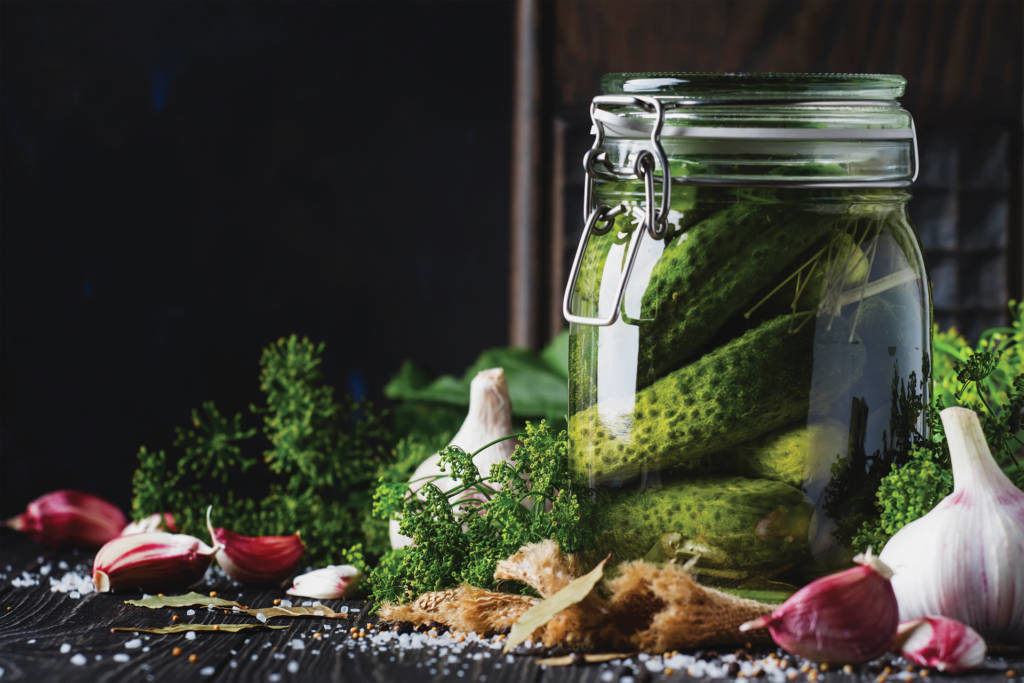The category is expansive, too. “Fermentation touches so many different products from sourdough bread, to almost every alcoholic beverage,” said Neal Vitale, Executive Director of The Fermentation Association. “There’s an involvement with fermentation in so many areas.”
In the U.S., the fermented grocery category is transforming. “Fermentation is all over the place,” says Vincent Finazzo, Owner of Riverwards Produce, located in Philadelphia. “I have multiple shelves of fermented products for sale, from tempeh to kimchi.” Finazzo stocks fermented vegetables, twists, sauerkraut, kimchi, white kimchi with fennel, farro, miso, apple cider vinegar, custom worcestershire sauces, sorghum vinegar, and fermented sausage. Finazzo’s most popular fermented products include kimchi, misos, and sauerkraut, but horizons are expanding. “Today, my customers are very interested in other bread options like fermented sourdoughs, which are great for people with a gluten intolerance.” And to help people work these healthy options into their diets, shoppers can also find cookbooks on fermented foods at Riverwards Produce.
Speaking to the evolution of the category, Sjon Welters, General Manager, Rhapsody Natural Foods, in Cabot, VT, says, “First we had sauerkraut, dill pickles, and soy sauce before WWII, then came yogurt in the 50s, and fancy fermented cheeses in the 60/70s, next was tofu in the 80s, then came tempeh in the 90s and miso (00s), kombucha and other fermented beverages (10s), now it will be natto as the next big thing.” And Welters should know: “We have been in the fermented food business since 1975 and the trend is clear—not only is the interest in traditional Western-style fermented foods like sauerkraut, yogurt, dill pickles, etc. stronger than ever, traditional foods from other cultures are entering consumers’ consciousness such as tempeh, miso, and natto to koji.”
The category is expanding, in part because of recognition and understanding of the fermentation processes. “There’s increased awareness particularly in the natural and specialty food channels, as well as the conventional food channels,” says Matt Reynolds, Brand Manager, Bubbies Fine Foods. Today, Reynolds says, consumers have better perceived benefits of fermented food and its process.
Here, a look at what’s new and trending in the category:
Pickles. Bubbies manufactures a range of fermented products, most notably their sweet pickles, sauerkraut, and relish horseradish. Fermentation isn’t the easiest production process, but the end product and flavoring is worth it, Reynolds says. More than just a side or add-on, Bubbies provides recipes that incorporate fermented favorites to remind their customers of homemade recipes and traditions. One recipe for brownies incorporates sauerkraut, which makes brownies softer.
Kelp Kimchi. Atlantic Sea Farms has taken fermented favorites to the next level by working with 24 fishermen up and down the coast to grow kelp in their state-of-the-art nursery. This mutualistic effort allows Atlantic Sea Farms to create fermented seaweed salad, sea-beet kraut, and their most popular offering, sea-chi, a mild kelp-based kimchi which was a nominee for the 2020 Good Food awards.
“Cleanly grown kelp and marine fiber is a great source of iodine for thyroid health, more calcium per ounce than milk, magnesium, potassium, and minerals,” says Jesse Baines, Sales and Marketing Director at Atlantic Sea Farms. Baines notes the importance of sourcing. “By helping the fisherman grow kelp, we’re growing the coastal economy in a sustainable way. Kelp is one of the most regenerative crops, grown via aquaculture. Atlantic Sea Farms saw an opportunity to not only diversify our coastal economy in Maine, but also to introduce clean, domestic, super tasty fresh kelp products to the U.S. market.”
Miso. “Miso might seem like a specialty ingredient for expert kitchens only, but it is worthy of a venerated place right alongside aged cheese for its saltiness, demiglace for its depth of flavor, butter for its richness, wine for its layered complexity, and olive oil for its usefulness,” says Leila Bakkum, National Sales Director at Great Eastern Sun. The company’s “miso master miso” is naturally aged without accelerants or preservatives and packed with probiotics to support gastrointestinal tract health, the company says. Their top sellers include mellow white, sweet yellow, red miso and chickpea miso. Bakkum’s advice: “Every retailer should have chickpea miso on their shelf.”
Natto. The traditional Japanese fermented soybean, natto, is likely to take the spotlight in the coming year, according to Welters. Best eaten at room temperature, natto beans are high in vitamins K2, C, and B6, and contain nattokinase, pyrroloquinoline quinone, Bacillus subtilis natto bacteria, magnesium and zinc, says Welters. Recent studies, he adds, link proper vitamin K2 intake to reduced risk of certain cancers and diabetes, among other benefits, and nattokinase with proper clotting mechanisms, aiding digestive disorders, and breaking down plaques associated with Alzheimers. (Both are also linked to heart health. Go here for more.)
Beverages. The fermented beverage category is made up of a range of drinks including Sima, a Finnish lemon and sugar drink; switchel; fermented tea, wine, and beer; Bouza, an eastern European millet based drink; gut shots, Kefir, ginger beer, and apple cider vinegar. In the category, fermented beverage manufacturers are experimenting with new flavors.
“Flavors like ginger, citrus, herbal and botanical blends are popular with core consumers, but we’re also seeing more mainstream flavors emerge—like apple, berry, and watermelon—which appeal to a wider audience,” says Amelia Winslow, MS, MPH, Brand Director, Health-Ade Kombucha. “Since we sold our first bottles in 2012, Pink Lady Apple and Ginger Lemon have ranked among our most popular flavors. But two of our newest, Tropical Punch and Passion Fruit Tangerine, are quickly becoming fan favorites too. They’re great stand-ins for cocktails for those who want to partake in festivities and still feel their best in the morning.”
Participating in the trend, Superior Switchel offers Lavender Lemon Lift Switchel which happens to pair well with other fermented products like cheese and gin, says Melina Lamer, CEO.
The mocktail and cocktail versions of fermented beverages have a wide appeal. Wild Tonic offers a unique take on fermentation for those under and over 21: Jun, made by fermenting tea and honey with a colony of bacteria and yeast, makes Wild Tonic rich in probiotics, prebiotics and amino acids. “Our top selling Wild Tonic alcohol flavors are Blueberry Basil, Mango Ginger and Raspberry Goji Rose,” says Holly Lyman, Queen Bee and Founder of Wild Tonic. “The organic honey instead of sugar leads to a light, refreshing flavor.” The company offers a non-alcohol, 5.6% or 7.6% ABV options.
Apple Cider Vinegar (ACV). ACV has been used for over 5,000 years for multiple uses including food preservation, combating infection and treating diseases (3). And awareness of health benefits is vast, according to Emilio Villarreal, Technical Services Director at Bragg Live Food Products. Acetic acid, a compound produced during fermentation and production of ACV, has been linked in studies to weight management, blood sugar control and support of the microbiome, he says. As a versatile product, Villarreal says ACV pairs well added to flat and sparkling water, tea, smoothies, in salads, marinades, mocktails, soups, and in fruit salads.
Possible trends: “We foresee new flavors for 2020 being anything fruity paired with herbs and spices that offer additional health benefits such as Ginger, Cinnamon and Turmeric,” says Villarreal. “And honey of course is always a crowd pleaser.”
Kefir. On the topic of versatility and innovation, Body Ecology’s coconut kefir is another product with an interesting origin story. “Years ago, I experimented on how to make a non-dairy kefir,” says Donna Gates, M.Ed., ABAAHP, international best-selling author and Founder of Body Ecology. “That’s when coconut kefir was born.” She says the company’s Cocobiotic and Innergybiotic fermented probiotic drinks are great for those who are looking for something to help reduce sugar intake. “And our Probiotic Protein Powder,” she adds, “is one of the only fermented vegan proteins on the market containing bioavailable fermented pea protein and some of the most highly researched probiotics.” Body Ecology also offers a Vitality Super Green powdered fermented alkaline drink made with spirulina, fermented algae and other immune strengthening ingredients.
New Opportunities in Fermented
In order to build a community around the expanding fermented products category, a number of industry specialists came together to form The Fermentation Association (TFA). At two years old, TFA will host the first ever Fermentation 2020 trade show hosted in Chicago, May 21-23, 2020. Since its inception, TFA has spent time developing a newsletter to keep industry professionals up-to-date on local news affecting the industry.“We felt there wasn’t enough attention on fermentation and it was an important category growing in a lot of different areas, touching a lot of different products,” says Neal Vitale, Executive Director of TFA. “Our goal is really to help consumers understand more about fermentation and ultimately to help producers of fermented products do more business.”
Awareness of fermentation’s health benefits has increased, he says. Consumers are more interested in what they’re consuming and the impact on their body and health, and are looking to eat naturally clean foods and beverages. Find out more on their site, www.fermentationassociation.org.
On the horizon
Going forward, manufacturers and retailers expect the continued surge in interest along with new flavors, unique combinations, and unexpected mixes. Trends will become bolder as consumers become bolder, says Reynolds. “You can ferment almost anything,” he says, “And so, what I expect is to see more brands do more interesting fermentations and flavor profile variations.” Since Asian cuisine, umami, health awareness, environmental consciousness, veganism, plant-based, and functionality continue to trend, fermented will continue to transform, says Bakkum.“How do we eat for the climate by looking at how people used to grow and eat food?” asks Baines. These are questions the food industry is thinking about. “Fermentation has its own space, and it aligns with sustainably eating for the climate. Even mainstream stores are honing in on sustainability on a deeper level. People are over the green-washing trend and they’re digging deeper. The Climate change diet is what we’re going to see a lot more in 2020. Clean ingredients, better for individuals and the planet.”
As far as kombucha, expect to see a take on new flavors and ingredients, such as caffeine and CBD, that will offer a new functionality for the category, says Winslow. Additionally, she says, we will see kombuchas move to new packaging, such as cans, to leverage lower price points, more placement opportunities in store and new distribution opportunities.
As awareness expands, retailers can benefit from demos and samples, say Bakkum. Also, Winslow adds, placing fermented options in the grab-and-go cooler really makes a difference. WF
References
1) Team at Fact.Mr, “Demand for Food Cultures Soars as Consumer Inclination for Fermented Food Increases, Finds Fact.MR” factmr.com. Posted 12/16/2019. Accessed 12/18/2019. https://www.factmr.com/media-release/1200/food-cultures-demand.
2) Bell, Victoria et al. “One Health, Fermented Foods, and Gut Microbiota.” Foods (Basel, Switzerland) vol. 7,12 195. 3 Dec. 2018, doi:10.3390/foods7120195. www.ncbi.nlm.nih.gov/pmc/articles/PMC6306734/.
3) Carnahan, Jill. “10 Science-Backed Benefits of Apple Cider Vinegar – Separating Facts from Fiction” Jillcarnahan.com. Accessed 1/6/2020. www.jillcarnahan.com/2019/01/29/10-science-backed-benefits-apple-cider-vinegar-separating-facts-fiction.










